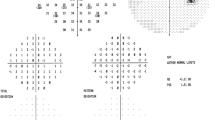Abstract
The Rodenstock Optic Nerve Head Analyzer was used to study the age distribution of the neuroretinal rim area in 194 eyes of 122 normal subjects aged 7–84 years. No significant linear correlation was found between neuroretinal rim area and age. Linear regression analysis of the neuroretinal rim area in the temporal disc quadrant as a function of age led to the following equation: y = 0.00029x + 0.245;r = 0.052. Linear regression analysis of the neuroretinal rim area in the total disc as a function of age led to the following equation: y = 0.001x + 1.314;r = 0.0053. The 99% confidence limits of the regression slope ranged from −0.0025 to +0.0045 (temporal disc quadrant) and from −0.00077 to +0.0013 (total disc), respectively. A nonlinear correlation between neuroretinal rim area and age is very unlikely. Using the Mann-Whitney U-test, no statistically significant difference between the smallest (group of subjects aged 7–19 years) and the largest mean neuroretinal rim area (group of subjects aged 30–39 years) was detectable. From our data we conclude that there are no age-related changes in the neuroretinal rim area as measured with the Optic Nerve Head Analyzer. Changes in the neuroretinal rim area during follow-up examinations of glaucoma suspects may therefore be interpreted as an important sign of early glaucomatous damage. This confirms our previous suggestion that follow-up examinations of the optic disc structure with the Rodenstock Optic Nerve Head Analyzer are useful to confirm the diagnosis of glaucoma, even at a stage where a visual field loss cannot yet be detected by routine perimetry.
Similar content being viewed by others
References
Armaly MF (1969) Cup/disc ratio in open angle glaucoma. Doc Ophthalmol 26:526–533
Bengtsson B (1976) The variation and covariation of cup and disc diameters. Acta Ophthalmol 54:804–818
Britton RJ, Drance SM, Schulzer M, Douglas GR, Mawson DK (1987) The area of the neuroretinal rim of the optic nerve in normal eyes. Am J Ophthalmol 103: 497–504
Caprioli J, Klingbeil U, Sears M, Bryony P (1986) Reproducibility of optic disc measurements with computerized analysis of stereoscopic video images. Arch Ophthalmol 104:1035–1039
Carpel EF, Engström PF (1981) The normal cup/disc ratio. Am J Ophthalmol 91:588–597
Colenbrander MC (1960) Measurements of the excavation. Ophthamologica 139:491–493
Cornsweet TN, Hersh S, Humphries JC, Beesmer RJ, Cornsweet DW (1983) Quantification of the shape and color of the optic nerve head. In: Brenin GM, Siegel IM (eds) Advances in diagnostic visual optics. Springer, New York Berlin Heidelberg, pp 141–149
Ford M, Sarwar M (1963) Features of a clinically normal optic disc. Br J Ophthalmol 47:50–52
Funk J, Grehn F (1989) Einfluß drucksenkender Operationen auf die neuroretinale Randzone der Papille. Fortschr Ophthalmol (in press)
Funk J, Bornscheuer C, Grehn F (1988) Neuroretinal rim area and visual field in glaucoma. Graefe's Arch Clin Exp Ophthalmol 226:431–434
Funk J, Bornscheuer C, Grehn F (1988) Zusammenhang zwischen neuroretinalem Randsaum der Papille und Gesichtsfeld beim Glaukom. Fortschr Ophthalmol 85:452–455
Gramer E, Klingbeil U (1986) Quantitative Papillenanalyse mit dem Optic Nerve Head Analyzer. Z Prakt Augenheilkd 7:30–36
Littmann H (1982) Zur Bestimmung der wahren Größe eines Objektes auf dem Hintergrund des lebenden Auges. Klin Monatsbl Augenheilkd 180:286–289
Lotmar W, Goldmann H, Brückner R (1978) Zur Bestimmung zeitlicher Veränderungen der Papille bei normalen Erwachsenen. Klin Monatsbl Augenheilkd 173:480–486
Motolko M, Drance SM (1981) Features of the optic disc in preglaucomatous eyes. Arch Ophthalmol 99:1992–1994
Pederson JE, Anderson DR (1980) The mode of progressive disc cupping in ocular hypertension and glaucoma. Arch Ophthalmol 98:490–495
Pickard R (1935) The clinical course of cavernous atrophy and its relation to the normal enlargement of the optic disc cup. Trans Ophthalmol Soc UK 55:599–621
Pickard R (1948) Alteration in size of normal disc cup. Br J Ophthalmol 32:355–361
Schwartz B (1973) Cupping and pallor of the optic disc. Arch Ophthalmol 89:272–277
Shields MB, Martone JF, Shelton AR, Ollie AR, MacMillan J (1987) Reproducibility of topographic measurements with the optic nerve head analyzer. Am J Ophthalmol 104:581–586
Siebert M, Gramer E, Leydhecker W (1988) Papillenparameter bei Gesunden — quantifiziert mit dem Optic Nerve Head Analyzer. Klin Monatsbl Augenheilkd 192:302–310
Snydecker D (1964) The normal optic disc. Am J Ophthalmol 58:958–964
Author information
Authors and Affiliations
Rights and permissions
About this article
Cite this article
Funk, J., Dieringer, T. & Grehn, F. Correlation between neuroretinal rim area and age in normal subjects. Graefe's Arch Clin Exp Ophthalmol 227, 544–548 (1989). https://doi.org/10.1007/BF02169450
Received:
Accepted:
Issue Date:
DOI: https://doi.org/10.1007/BF02169450




